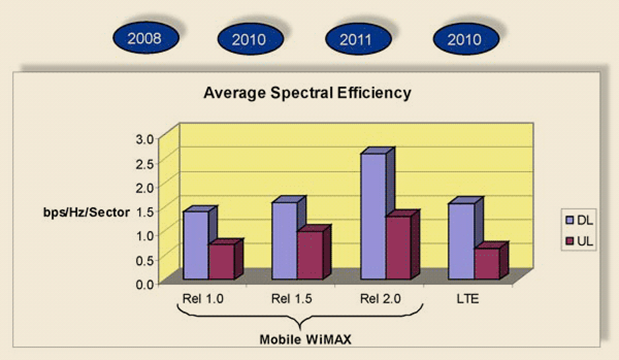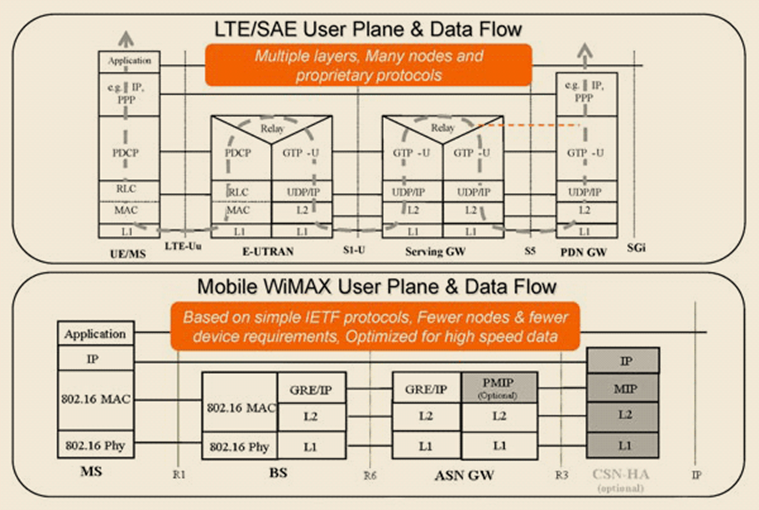
- •1. Review of current systems for broadband wireless access
- •1.1 Comparison of key technologies WiMax and hspa
- •1.2 Comparison of the key technologies for WiMax and lte
- •1.3 Comparison of key technologies WiMax and Wi-Fi.
- •2.2 Standard 802.16: physical layer
- •2.3 Standard 802.16 Protocol mac sublayer
- •2.4 Standard 802.16: frame structure
- •In addition to the data ofdm6символ includes a guard interval duration Tg, so that the total duration of the ofdm symbol
- •3.2 Mesh network
- •3.3 Application Features multiple access ofdma
- •In addition to reviewing the methods of distribution of bearing, the standard and optional mechanisms - in particular, the so-called optional fusc, not fundamentally different from that considered.
- •3.4 Support for adaptive antenna system
- •In more detail the network architecture shown in figure 19:
- •Variant mimo with a single receiving antenna also known as the mode stc (Space Time Coding with space-time coding) and are particularly suitable in nlos conditions.
- •In turn, the values and are defined by the formulas
- •7.2 The choice of the equipment of base stations
1.1 Comparison of key technologies WiMax and hspa
System with HSPA (3GPP release 6) commercially available since 2007. The technology provides a frequency dupliciranje (FDD) with the width of each duplex channel 5 MHz. In the downward channel is used modulation QPSK or 16-QAM, streaming speeds of 14 Mbps. In the ascending channel, BPSK modulation, the peak speed of 5.8 Mbps.
At the same time on the market were the WiMAX system (release 1.0) with a temporary dupliciranjem (TDD). Under similar bandwidth 10 MHz they provide the speed in the downward channel is 2-3 times higher than HSPA (as WiMAX TDD when the total bandwidth is dynamically shared between downward and upward channels).
Table 2. Comparison of HSPA systems (releases 7 and 8) and WiMAX (release 1.5)
|
Settings |
HSPA |
WiMAX |
||||||
|
Version |
Релиз 7 |
Релиз 8 |
Релиз 1.5 |
|||||
|
The GHz Range |
2.0 |
2.5 |
||||||
|
Dupliciranje |
FDD |
FDD |
TDD |
|||||
|
The channel bandwidth MHz |
2х5 |
2х5 |
10 |
|||||
|
Antenna BS |
1х2 |
2х2 |
2х2 |
|||||
|
Antenna AC |
1х2 |
1х2 |
||||||
|
Modulation and encoding rate |
||||||||
|
In a descending channel |
64 QAM 5/6 |
16 QAM 3/4 |
64 QAM 5/6 |
64 QAM 5/6 |
||||
|
In an upside channel |
16 QAM 3/4 |
64 QAM 5/6 |
||||||
|
Peak rate, Mbps |
||||||||
|
In a descending channel |
17,5 |
21 |
35 |
36 |
48 |
|||
|
In an upside channel |
8,3 |
8,3 |
8,3 |
17 |
24 |
|||
The development of technology has created HSPA+ (HSPA release 7 and some of the amendments release 8). In a descending channel they are distinguished by modulation 64-QAM c SIMO (1x2) or 64-QAM SIMO c (2x2). The ascending channel added modulation 64-QAM and enhanced features for VoIP. Amended in accordance with release 8, you can use in a descending channel mode MMO (2x2) with modulation 64-QAM, the possibility of using Mobilisa orders of magnitude in a descending channel and MMO (2x2) - the ascending channel.
When comparing mobile WiMAX and HSPA+, you can make the following conclusions:
-mobile WiMAX release 1.5) is comparable to HSPA+ (release 8) peak speed in a descending channel with the same modulation, coding rate and channel width. While mobile WiMAX in the ascending channel peak rate 2-3 times higher.
-System HSPA+ is limited by the channel width of 2x5 MHz in the traditional spectral conditions of 3G networks. Mobile WiMAX supports bandwidth up to 20 MHz as frequency and temporal dupliciranje. Its frequency profiles are planned in the range of 700, 1700, 2300, 2500 and 3500 MHz. Mobile WiMAX provides a "smooth IP network" (from end to end).
1.2 Comparison of the key technologies for WiMax and lte
The next step of evolution of 3GPP systems are system Long Term Evolution (LTE). They are distinguished by the OFDMA technology in a descending channel and SC-FDMA in uplink. Modulation - 64-QAM, channel width to 20 MHz, dupliciranje TDD and FDD. Applied adaptive antenna systems, flexible network access. Network architecture fully IP network. In the LTE system is applied technologies and methods already used in mobile WiMAX, so we should expect similar performance of LTE systems (table 1-2 and 1-3).
Table 3. The comparison of the parameters of real systems LTE WiMAX and molar (release 1.5) in the same frequency conditions at FDD with stripes h MHz
|
Settings
|
LTE |
WiMAX Релиз 1.5 |
|||
|
Motorolla |
T-Mobile |
Qualcomm |
|||
|
Down channel |
|
|
|
|
|
|
Antenna BS |
2х2 |
2х4 |
4х2 |
2х2 |
4х4 |
|
Modulation and encoding rate |
64 QAM 5/6 |
64 QAM 5/6 |
64 QAM 5/6 |
64 QAM 5/6 |
|
|
Speed Mbps |
226 |
144 |
277 |
144,6 |
289 |
|
Ascending channel |
Нет данных |
|
|
|
|
|
Antenna AC |
1х2 |
1х2 |
1х2 |
||
|
Modulation and encoding rate |
64 QAM 5/6 |
64 QAM 5/6 |
64 QAM 5/6 |
||
|
Speed Mbps |
50,4 |
75 |
69,1 |
||
The LTE system is a revolutionary improvement in 3G. LTE represents the transition from CDMA to OFDMA systems, as well as the transition to a fully IP system to the communication packets. Therefore, the introduction of this technology on existing cellular networks means you need a new radio resources to obtain benefits from broad channel. For backward compatibility required dual mode subscriber device. Therefore, a smooth transition from 3G to LTE is very complicated.
Table 4. Comparison of key parameters of LTE and WiMAX
|
Settings |
LTE |
WiMAX Релиз 1.5 |
|
1 |
2 |
3 |
|
Dupliciranje |
FDD и TDD |
FDD и TDD |
|
The frequency range for analysis |
2000 МГц |
2500МГц |
|
Channel width |
До 20 МГц |
До 20 МГц |
|
From the base |
OFDMA |
OFDMA |
|
Kbase |
SC-FDMA |
OFDMA |
|
Spectral efficiency, bits/Hz/s |
||
|
A downward channel, MIMO (2x2) |
1,57 |
1,59 |
|
Ascending channel, SIMO (1x2) |
0,64 |
0,99 |
|
The maximum speed of the mobile station km/h |
350 |
120 |
|
Frame duration, MS |
1 |
5 |
|
Antenna systems |
||
|
Down channel |
2х2, 2х4, 4х2, 4х4 |
2х2, 2х4, 4х2, 4х4 |
|
Down channel |
1х2, 1х4, 2х2, 2х4 |
1х2, 1х4, 2х2, 2х4 |

Figure 1 - Comparison of the average spectral efficiency.
Note that the advantage in spectral efficiency means winning in the cost of network deployment (including unit costs relative to network bandwidth). In addition, increasing the channel capacity, allowing operators to introduce additional services. Mobile WiMAX is smooth IP network, the LTE network is more complex (figure 2).

Figure 2 - Comparison of system architectures WiMAX and LTE
If the WiMAX network is based entirely on IP protocols IEEE, the LTE network is more complex, involves more protocols, including proprietary protocols 3G. It is important that intellectual property in the field of WiMAX technology, the relevant patents are distributed among many companies, created open patent Alliance, which reduces the prices of subscriber devices.
Conclusions comparison of WiMAX and LTE:
- WiMAX, and LTE meet the objectives of IMT-Advanced;
specifications of IMT-Advancedеще not fully defined;
- IEEE802.16m will fully reflect the specifications and requirements of IMT-Advanced;
-mobile WiMAX release 1.5 and LTE share similar characteristics. In both on-line database is used OFDMAс multilevel modulation and coding. Peak speed is almost the same with the same multiplicities modulation speeds and correcting code. In both used and FDD, and TDD duplexsonography channel width to 20 MHz. In both uses MIMO large multiplicities and reduction of delays;
-mobile WiMAX has a two-year time to market and smooth e2e IP network architecture;
- throughput and spectral efficiency of mobile WiMAX release 2.0 has better options than LTE;
mobile WiMAX release 2.0 is compatible with releases 1.0 and 1.5;
- investments for network transformation from 2G/3Gв LTEи in mobile WiMAXпримерно same;
-and for LTE networks and WiMAX networks requires a new range;
-both networks need a multi-mode subscriber devices;
